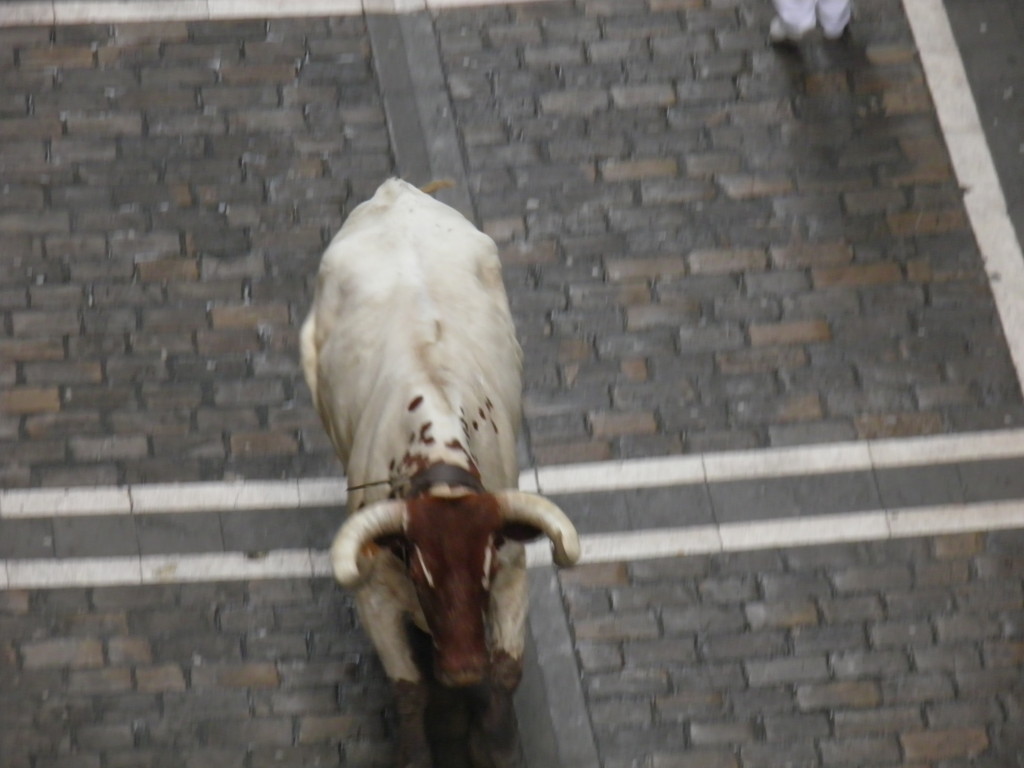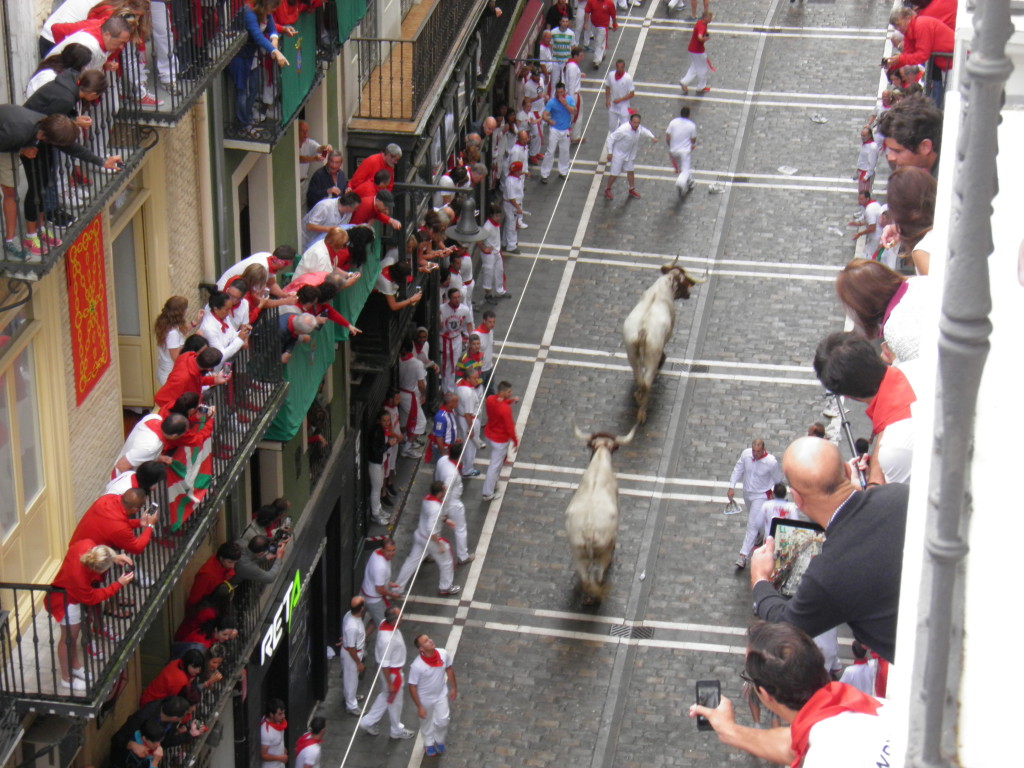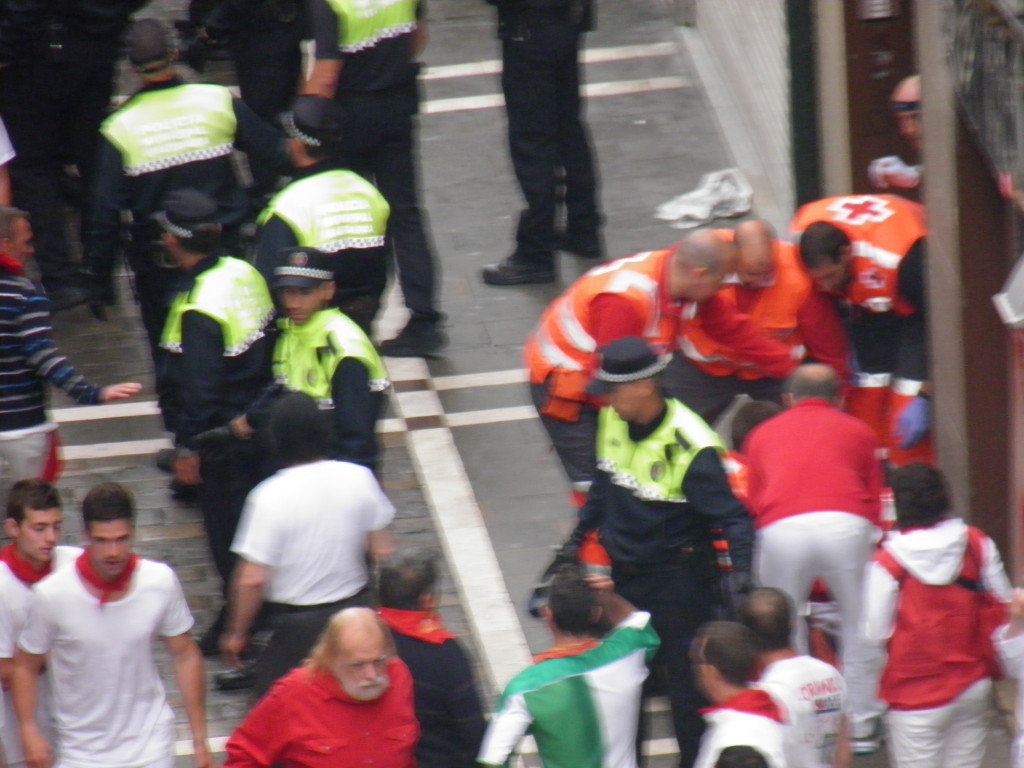Off to Spain I go to See the Running of the Bulls
Review: Air France Business Class, IAD to CDG to BCN
Review: Four Points by Sheraton Barcelona Diagonal
Review: The Gran Hotel La Perla, Pamplona
The San Fermin Festival
The Running of the Bulls
Review: Renfe Alvia Train, Pamplona to Madrid
Review: Gran Melia Fenix, Madrid
The Running of the Bulls is one of those “bucket list” items everyone needs to do…now, I don’t mean necessarily running with the bulls, but rather watching the running of the bulls. It was perhaps one of the best travel moments I’ve ever had, and to go along with it, I think I snapped some great pictures.
For the week following July 7, every morning at 8am, there is a bull run (the “Encierro”) in Pamplona, Spain. The absolute BEST public location to view this at is the Gran Hotel La Perla, with rooms facing Estafeta St. You can rent a balcony in someone’s private home or business for around 100 Euros, however I enjoy the privacy the hotel has, and not having to worry about other people. Rates are sky-high during the San Fermin Festival, however there is no better place to enjoy the excitement.
Here’s my video of the entire running of the bulls, as seen from the 4th floor balcony of my room at the Gran Hotel La Perla:
So, let’s dissect the parts of the run for all you newbies out there:
The Encierro … The Running of the Bulls
The Encierro is the event at the heart of the Sanfermines and makes the fiesta a spectacle that would be unimaginable in any other place in the world. It was born from need: getting the bulls from outside the city into the bullring. The encierro takes place from July 7th to 14th and starts at the corral in Calle Santo Domingo when the clock on the church of San Cernin strikes eight o”clock in the morning. After the launching of two rockets, the bulls charge behind the runners for 825 metres, the distance between the corral and the bullring. The run usually lasts between three and four minutes although it has sometimes taken over ten minutes, especially if one of the bulls has been isolated from his companions.
Chants to San Fermin
The bull run has a particularly emotional prelude. It is when the runners, just a few metres up the slope from the corral where the bulls are waiting, raise their rolled newspapers and chant to an image of San Fermin placed in a small recess in the wall in the Cuesta de Santo Domingo. Against the strongest of silences, the following words can be heard: “A San Fermin pedimos, por ser nuestro patron, nos guie en el encierro dandonos su bendicion.” (We ask San Fermin, being our patron saint, to guide us in the bull run and give us his blessing). When they finish they shout “Viva San Fermin!, Gora San Fermin.” This chant is sung three times before 8am first, then when there are five minutes to go before 8am, then three minutes and one minute before the gate of the corral is opened.
Rockets in the bullring
The third rocket, fired from the bullring, signals that all the bulls have entered the bullring. A fourth and final rocket indicates that all the bulls are safely in the corral located inside the bullring, and that the bull run has ended.
A fence of 3,000 parts
For security reasons, a double fence marks out the route of the bull run through the streets. It is made of over 3,000 wooden parts (planks, posts, gates, etc.). Part of the fence stays put throughout the fiesta but other sections are assembled and disassembled every day by a special brigade of workers.
The role of the pastores
A large number of pastores (bull “shepherds”) cover the entire bull run. They place themselves behind the bulls, with their only protection being a long stick. Their main role is to stop the odd idiot from inciting the bulls from behind, to avoid the bulls turning round and running backwards, and to help any bulls that have stopped or have been separated from their companions to continue running towards the bullring.
The dobladores
Other key people in the bull run are the dobladores, people with good bullfighting knowledge (sometimes ex-bullfighters) who take up position in the bullring with capes to help the runners “fan out” (in other words, run to the sides after they enter the bullring) and “drag” the bulls towards the corral as quickly as possible.
The two groups of mansos (bullocks)
The six fighting bulls that will take part in the evening bullfight start the run accompanied by an initial group of mansos, which act as “guides” to help the bulls cover the route. Two minutes after leaving the corral in Santo Domingo, a second group of bullocks (the so-called “sweep-up” group), which are slower and smaller than the first one, are let out to lead any bulls that might have stopped or been left behind in the bull run towards the bullring.
During the bull run, all of the streets in the area are closed off, so if you’re on foot, you’ll have to gain a vantage point inside a local’s house, a business or in one of the fenced in areas. Medical staff and police surround the route and rush in when a runner goes down. From my lookout area, I saw at least 10 different people either collapse, get shoved violently, or, worse, get trampled by the bulls themselves. This is not a run for the faint of heart, and is something I would not recommend anyone doing themselves – combine yourselves with a bunch of drunk Spaniards, and you’re in a one way ticket to the hospital.
This is a testament to experience the local culture when you travel. Don’t just go to those standard museums. Don’t just find the famous places to eat. Experience the local culture, and do what the locals do…you’ll never forget it.
Warning: Some of the pictures below may be graphic in nature. Viewer discretion is advised.
























 Jamie Larounis is an avid traveler, blogger and miles/points educator. Traveling well over 100,000 miles a year and staying in hotels for over 100 nights, he leverages miles, points and other deals to fly in first class cabins, and stay in 5-star hotels. The Forward Cabin shares his experiences, musings, reviews, tips, tricks, resources and industry news with you, the fellow traveler.
Jamie Larounis is an avid traveler, blogger and miles/points educator. Traveling well over 100,000 miles a year and staying in hotels for over 100 nights, he leverages miles, points and other deals to fly in first class cabins, and stay in 5-star hotels. The Forward Cabin shares his experiences, musings, reviews, tips, tricks, resources and industry news with you, the fellow traveler.
Awesome post, James! What an amazing experience! Can anyone run or do you have to register? Just curious. It seems to me the likelihood of getting trampled over by the bulls is higher than getting gored, no?